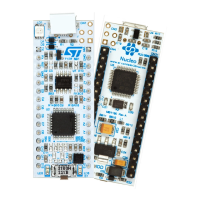UM1724 Rev 14 23/68
UM1724 Hardware layout and configuration
67
6.4 LEDs
The tricolor LED (green, orange, red) LD1 (COM) provides information about ST-LINK
communication status. LD1 default color is red. LD1 turns to green to indicate that
communication is in progress between the PC and the ST-LINK/V2-1, with the following
setup:
• Slow blinking Red/Off: at power-on before USB initialization
• Fast blinking Red/Off: after the first correct communication between the PC and
ST-LINK/V2-1 (enumeration)
• Red LED On: when the initialization between the PC and ST-LINK/V2-1 is complete
• Green LED On: after a successful target communication initialization
• Blinking Red/Green: during communication with the target
• Green On: communication finished and successful
• Orange On: Communication failure
User LD2: the green LED is a user LED connected to ARDUINO
®
signal D13 corresponding
to STM32 I/O PA5 (pin 21) or PB13 (pin 34) depending on the STM32 target. Refer to
Table 11 to Table 23 when:
• the I/O is HIGH value, the LED is on
• the I/O is LOW, the LED is off
LD3 PWR: the red LED indicates that the STM32 part is powered and +5V power is
available.
6.5 Push-buttons
B1 USER: the user button is connected to the I/O PC13 (pin 2) of the STM32
microcontroller.
B2 RESET: this push-button is connected to NRST, and is used to RESET the STM32
microcontroller.
Note: The blue and black plastic hats that are placed on the push-buttons can be removed if
necessary, for example when a shield or when an application board is plugged on top of the
Nucleo board. This will avoid pressure on the buttons and consequently a possible
permanent target STM32 RESET.
6.6 JP6 (IDD)
Jumper JP6, labeled IDD, is used to measure the STM32 microcontroller consumption by
removing the jumper and by connecting an ammeter:
• Jumper ON: STM32 microcontroller is powered (default).
• Jumper OFF: an ammeter must be connected to measure the STM32 microcontroller
current. If there is no ammeter, the STM32 microcontroller is not powered.

